Physical Address
304 North Cardinal St.
Dorchester Center, MA 02124
Open-heart surgery was commonly used in the past to treat refractory ventricular arrhythmias (VAs). The predominant population subjected to this management strategy was made up of patients with healed myocardial infarcts who experienced sustained ventricular tachycardia (VT). The original technique used resection of the dyskinetic/akinetic scarred myocardial tissue (aneurysmectomy) and had only modest success (∼40%) for long-term arrhythmia control. Subsequent mapping studies revealed that critical components of the VT reentrant circuit used the border zone between the dense scar and healthy myocardium. This resulted in the development of subendocardial resection (removing tissue up to a depth of 2–4 mm in the area surrounding the dense aneurysm), which improved the overall success rate of long-term arrhythmia control to 90%. Subsequent innovations in mapping tools (multielectrode epicardial shock and endocardial basket) allowed operators to better characterize VT circuits for more effective surgical ablation. Nevertheless, a major limitation remained the highly invasive nature of the procedure (median sternotomy with cardiopulmonary bypass and ventriculotomy). Furthermore, because this surgery was typically performed on sick patients with impaired cardiac function (who had experienced recurrent VAs refractory to multiple antiarrhythmic drugs [AADs]), the periprocedural mortality rate was high. , , , For these reasons, this surgical technique was never widely adopted. With the invention of implantable cardioverter-defibrillators (ICDs) and advances in percutaneous catheter mapping and ablation techniques, there was a steady decline in surgical VT ablation, leaving it as a rarely used technique for treating refractory VAs in a select group of patients.
Surgical VT ablation is generally a treatment of last resort reserved primarily for patients who have failed a combination of AADs and percutaneous catheter ablation attempts. , The more contemporary experience at the Hospital of The University of Pennsylvania is consistent with this observation. Over an 8-year period (2007–2015), 2353 patients underwent VT ablations at our center. Of these, 608 patients (25.8%) had heart disease categorized as nonischemic based on the lack of a prior infarct and absence of coronary disease. In 21 of these patients (3.5%, 18 males), all with a nonischemic substrate (median left ventricular [LV] ejection fraction of 41% ± 20%), the arrhythmia remained refractory to medications and endocardial/epicardial percutaneous radiofrequency (RF) ablation attempts. These patients eventually underwent surgical VT ablation for arrhythmia control. Eleven patients had idiopathic dilated cardiomyopathy, four had valvular cardiomyopathy, two had long-standing hypertrophic cardiomyopathy, and three had arrhythmogenic right ventricular (RV) dysplasia/cardiomyopathy. Cardiac magnetic resonance imaging (MRI) was performed in 13 patients, and late gadolinium enhancement was identified in the midmyocardium in four patients, subepicardium in three, and interventricular septum (IVS) in six. The latter group was particularly interesting because in the majority, the basal septum was markedly thickened (>20 mm). Consistent with these observations, case reports from other investigators also suggest that VAs arising from the basal IVS are challenging to ablate percutaneously. Thus, in patients with VT, which manifests electrocardiogram (ECG) characteristics suggestive of origin from the IVS region, attempts should be made a priori to identify septal scar using MRI, positron emission tomography (PET) scan, and transthoracic or intracardiac echocardiography ( Fig. 136.1 ). Typical ECG features suggesting VT origin from the IVS region include (1) left bundle branch block morphology with superior or inferior axis and early precordial transition (before lead V 3 ) or (2) right bundle branch block morphology with inferior or superior axis and an unusual precordial transition pattern with lead V 2 manifesting predominantly negative complexes (rS or QS) compared with leads V 1 and V 2 ( Fig. 136.2 ). , In these cases, especially if a scar is identified in the IVS, it is prudent to make the patient aware of the possibility that percutaneous catheter ablation may not be successful. Similarly, in patients with LV hypertrophy who have VAs in the setting of midmyocardial scar, consideration should be given to a surgical option if an attempt at percutaneous catheter ablation fails. ,
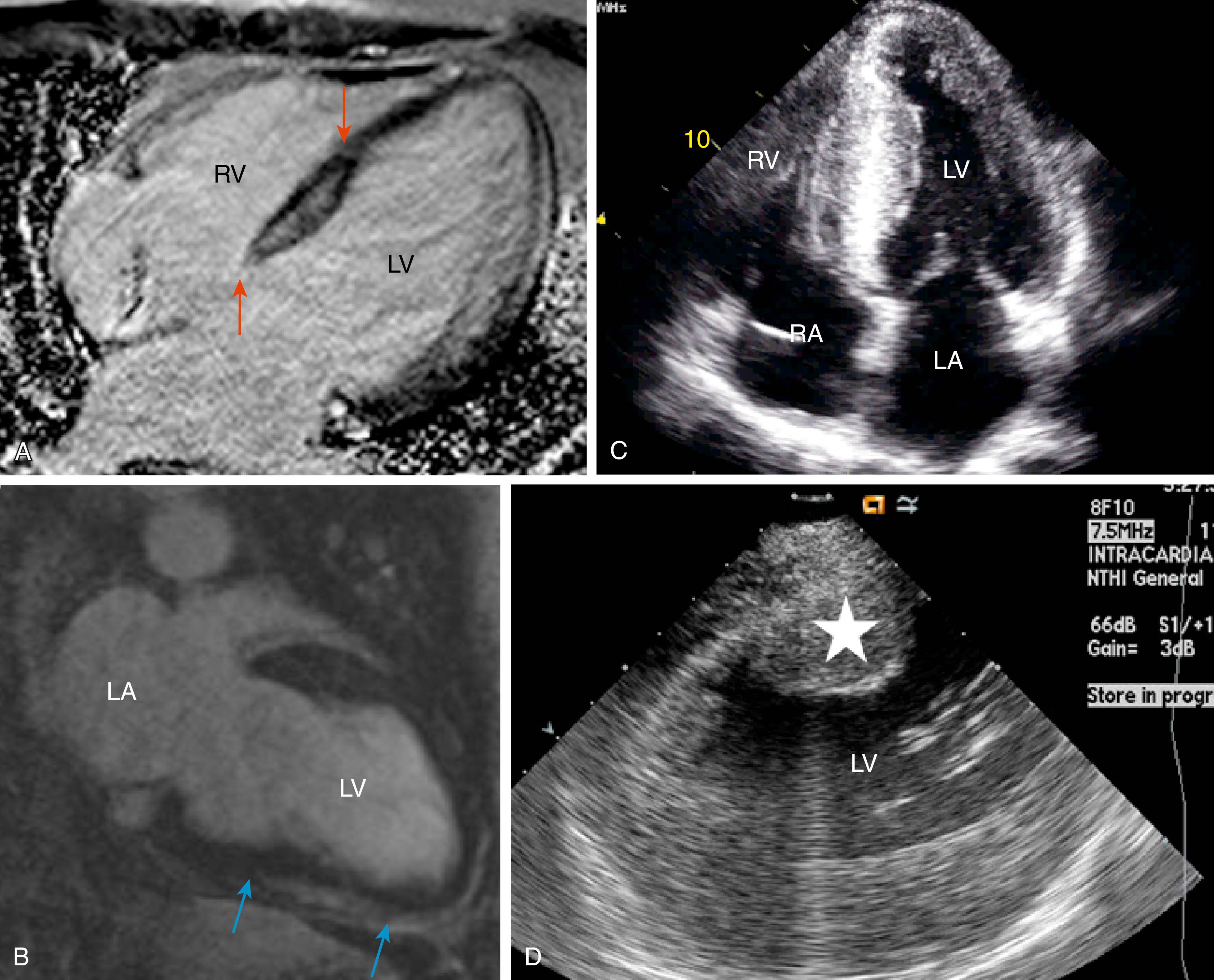
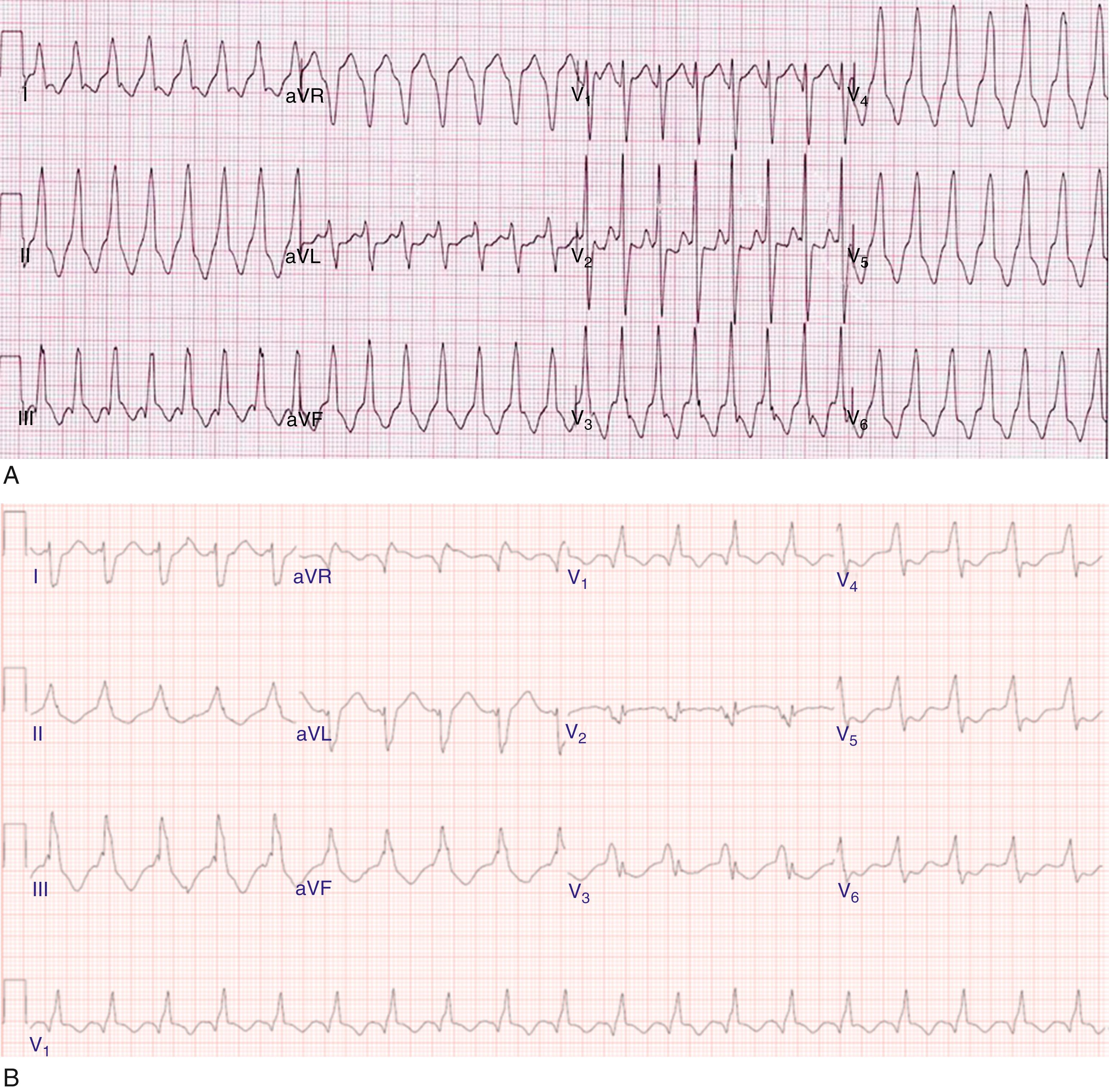
Surgical ablation of VAs should be considered in patients who are undergoing open-heart surgery for other cardiac pathology, such as valve surgery, coronary artery bypass grafting, or implant of a ventricular assist device (VAD) and who have manifested recurrent VT despite AAD therapy and/or percutaneous catheter ablation attempts. We have recently reported our experience with surgical VT ablation in six patients undergoing left VAD placement. Patel and colleagues have also reported a series of five patients. Unlike our approach where the VT substrate was targeted endocardially through the “cored-out” LV apex while on cardiopulmonary bypass before left VAD (LVAD) placement, Patel and colleagues allowed the patients to recover from the LVAD surgery for 24 to 48 hours and then performed open-chest electrophysiologic (EP) study and electroanatomic mapping (EAM) on the exposed heart in the hybrid operation room.
A recent case series has also reported on the utility of surgical VT ablation in patients with repaired tetralogy of Fallot (rTOF; see Chapter 116 ) undergoing repeat surgical intervention for pulmonary valve (PV) incompetence. Within the group of 118 rTOF patients that underwent PV replacement, these investigators identified 20 subjects considered to be at high risk for future development of VAs. The most common ablation sites were two putative isthmuses: one between the tricuspid valve and anterior RV outflow tract scar/patch and the other between the PV and septal scar/patch. These were targeted by linear lesion sets using RF energy (Cardioblate; Medtronic). Ablation was accomplished immediately before implantation of the PV prosthesis. The subsequent VT-free survival at 5 years was quite high (89.5%) in these patients.
Adequate access to all cardiac surfaces is critical to the success of surgical VT ablation. Median sternotomy typically provides the best visualization of the entire heart. , , , The epicardial aspect of the RV, superior IVS, and anterior LV wall are well visualized through median sternotomy without additional cardiac manipulation ( Fig. 136.3 ). To adequately inspect the posterolateral LV wall, however, the heart has to be physically lifted. Although this can cause a drop in cardiac output and blood pressure, proper pericardial and cardiac manipulation as conducted during off-pump coronary artery bypass grafting can facilitate good exposure of the posterolateral LV, without the need for cardiopulmonary bypass, for inspection and mapping if necessary. Actual ablation, particularly cryoablation, is typically best performed in our experience during cardiopulmonary bypass on an arrested heart to avoid the energy sink of warm blood within the heart that is expected to decrease lesion penetration. To access the LV endocardium, several options are available. The transaortic approach offers the best visualization of the basal LV, including the IVS region and the anterior and lateral LV walls. , To achieve this, a standard aortotomy, as for aortic valve (AV) replacement, is performed above the sinotubular junction. The AV leaflets are carefully retracted against the sinus of Valsalva, and the LV outflow tract is exposed (see Fig. 136.3 ). The IVS is seen immediately under the right coronary AV cusp. The basal anterior and lateral LV endocardium is visualized under the junction of right–left commissures and the left coronary cusp, respectively (see Fig. 136.3 ). A transatrial transmitral valve (MV) approach offers the best visualization of both papillary muscles, the posterior LV endocardium, and the LV apex. , , These structures are frequently involved in VT circuits in patients with healed inferior infarcts and can also be the source of VT in patients with nonischemic cardiomyopathy. In patients with mechanical aortic and mitral valves, an apical ventriculotomy has been used to access the LV endocardium. In patients undergoing surgical ventricular aneurysm repair, the site of aneurysmectomy can also be used to access the LV endocardium before aneurysm resection and closure. More recently, in patients undergoing LVAD placement, the “cored-out” LV apex (see Fig. 136.3 ) can provide access to the LV endocardium, as previously noted. The RV also can be accessed either via a transatrial transtricuspid valve approach or directly through the RV free wall. , An important difference between epicardial alone versus additional endocardial cardiac access pertains to cardiopulmonary bypass use. When the arrhythmia originates from the RV free wall or the inferior IVS region, access to these locations can be obtained by partial sternotomy, sparing the upper half of the sternum (see Fig. 136.3 ). The advantages of this approach are a shorter postprocedure recovery and more stable sternal healing. We have used this approach successfully in a patient undergoing ablation for refractory VT originating from the inferior IVS region and the anterior epicardial LV surface. There are also case series and larger patient experiences describing access to the epicardium using a surgical window via an epigastric incision with or without removal of the xiphoid process, , or a left thoracotomy using a limited left anterior incision extending from the third to fifth intercostal spaces. Both these techniques have been successfully accomplished in the cardiac EP laboratory. Using this approach in the EP laboratory, however, only the epicardial aspect of the inferior, anterior, and parts of the lateral cardiac surfaces were accessed ( ). Another technique for accessing the epicardial space surgically is through an apical thoracotomy. To accomplish this, the LV apex is identified by palpating the anterior chest wall, and an incision is placed in the precordium directly opposite the site of cardiac impulse and the epicardial surface exposed. This has become our preferred technique for creating the surgical window for mapping and ablating challenging VTs in the EP laboratory ( Fig. 136.4 ).
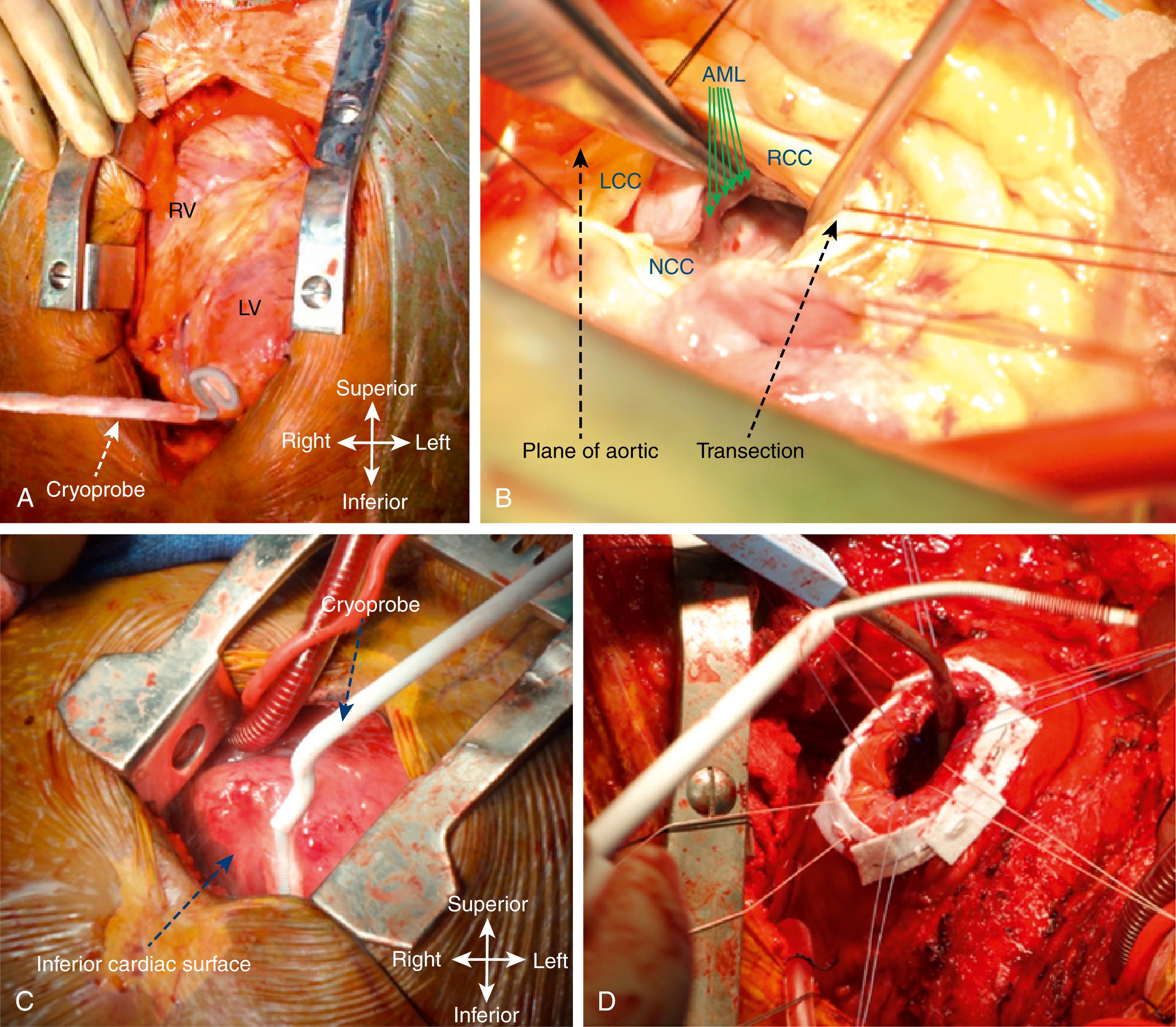
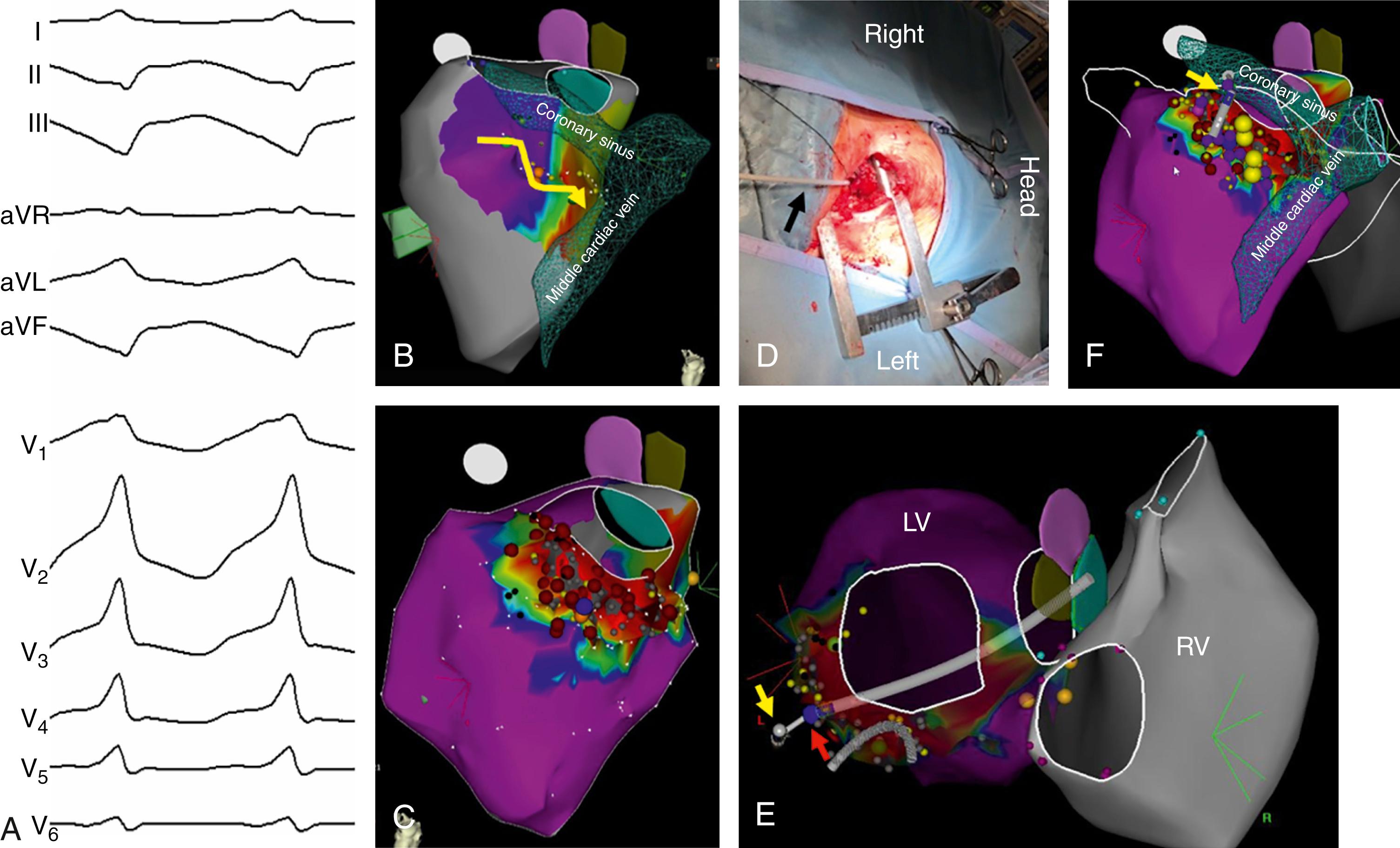
Early attempts at mapping VAs in the operating room (OR) used finger-mounted bipolar electrodes that were sequentially manipulated to various locations in the chamber of interest. , Subsequently, multipolar meshes and basket catheters were developed that had the ability to record simultaneous electrical activity at a higher resolution. , Nevertheless, interpretation of data required special signal processing that made these tools cumbersome to use in the OR. With the development of EAM techniques, electrophysiologists are now able to create a three-dimensional shell of the chamber of interest during ongoing arrhythmia. This tool provides more intuitive visualization of the tachycardia circuit vis-à-vis the underlying anatomy and substrate. EAM requires a low-intensity magnetic field around the patient, which requires a special setup. In hybrid ORs that are specifically designed for both percutaneous catheter and open-heart surgical interventions, use of advanced cardiac EP mapping tools, including EAM, is possible. , , To accomplish this, typically the electromagnetic source is set up under the operating table, reference electrodes are sutured to the epicardial surface of either ventricle (exposed via sternotomy), and the mapping catheter is manipulated on or within the chamber of interest ( Fig. 136.5 and ). To sustain and map VAs in the OR, however, the heart usually has to be actively “beating.” In some cases, VAs can be induced and sustained with the heart connected to the cardiopulmonary bypass machine but without aortic cross-clamping. In these instances, however, the cardiac temperatures on bypass need to be maintained in the normothermic range. Furthermore, if cryothermy is used for ablation, the most effective lesions are created on a cooled, cardioplegia-arrested heart. The downside of using cold cardioplegia is that it abolishes inducible VAs. , , Even without using cold cardioplegia, reproducible induction and maintenance of the clinical arrhythmia(s) during open-heart surgery (in patients under deep anesthesia) can be challenging. The loss of autonomic tone and the effects of various anesthetic agents coupled with underfilled hearts can make this hard. An alternative to mapping VAs in the OR is to perform detailed mapping a priori in the cardiac EP laboratory. We have used this strategy in the majority of patients who have undergone surgical VT ablation at our institution. , In each case, detailed endocardial and, when indicated, epicardial mapping of the arrhythmia was performed in the EP laboratory. Using activation, entrainment, and electroanatomic mapping, the critical components of the reentrant circuit and/or the site of origin of VT (vis-à-vis the underlying substrate) were characterized. These locations were then targeted using conventional RF energy. Although percutaneous RF ablation in these cases was not effective in suppressing the arrhythmias, in the OR, the RF lesions were identifiable and served as targets for cryothermy application ( Fig. 136.6 ). This precluded the need for additional arrhythmia induction or mapping during open-heart surgical ablation. In the OR (under cold cardioplegia), the cryoprobe was positioned over the RF lesion site and a full-duration (3 minutes) cryothermy application was made. This approach typically resulted in a large lesion, the induration from which could be palpated on the opposing surface (see Fig. 136.6 ). Thus cryolesions delivered on the endocardial surface could be palpated from the epicardial aspect and vice versa. As a result, it was possible to make an additional cryothermy application on the opposing cardiac surface to ensure a transmural lesion that would extend through the entire thickness of the targeted LV myocardium ( ).
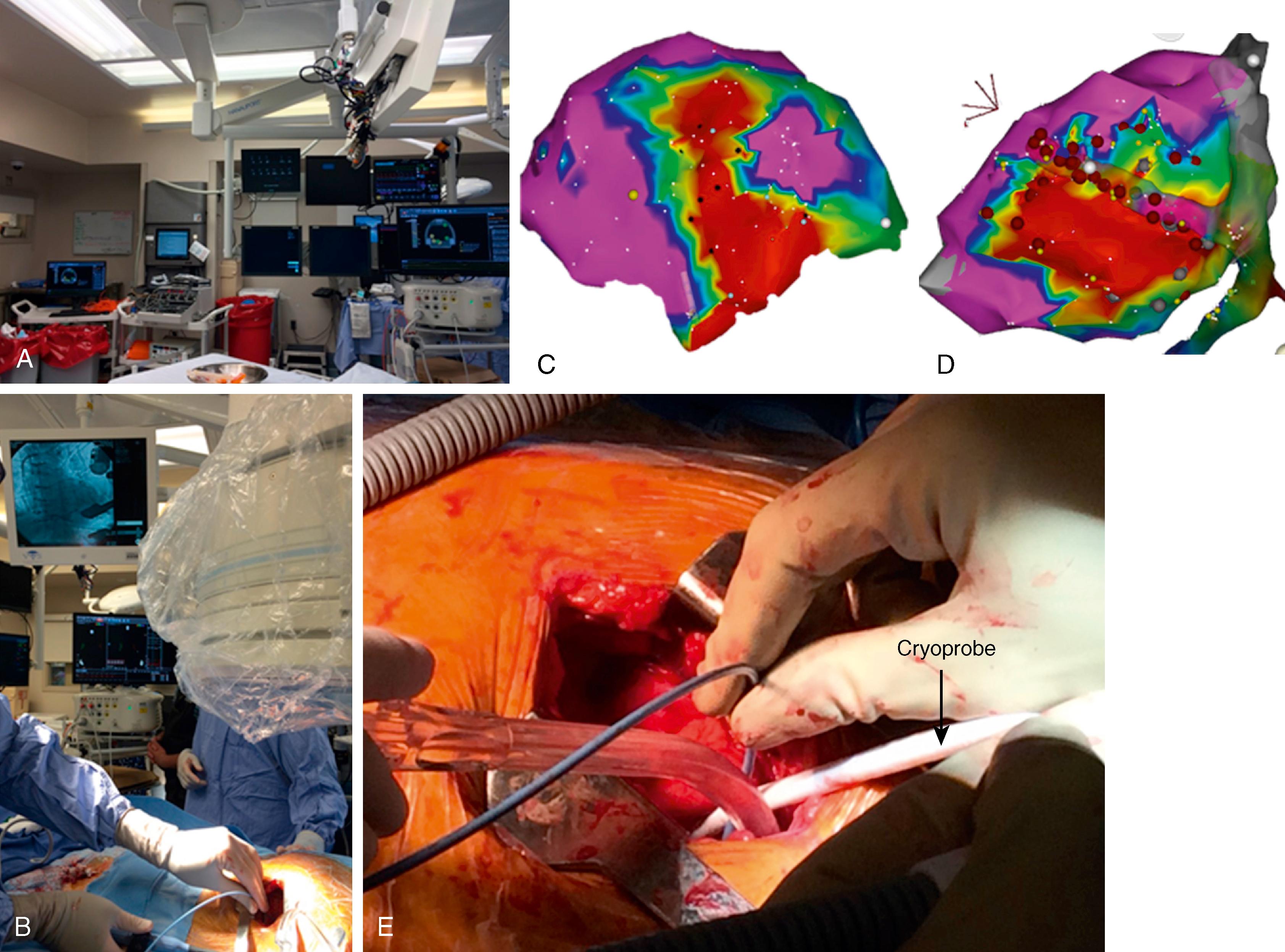
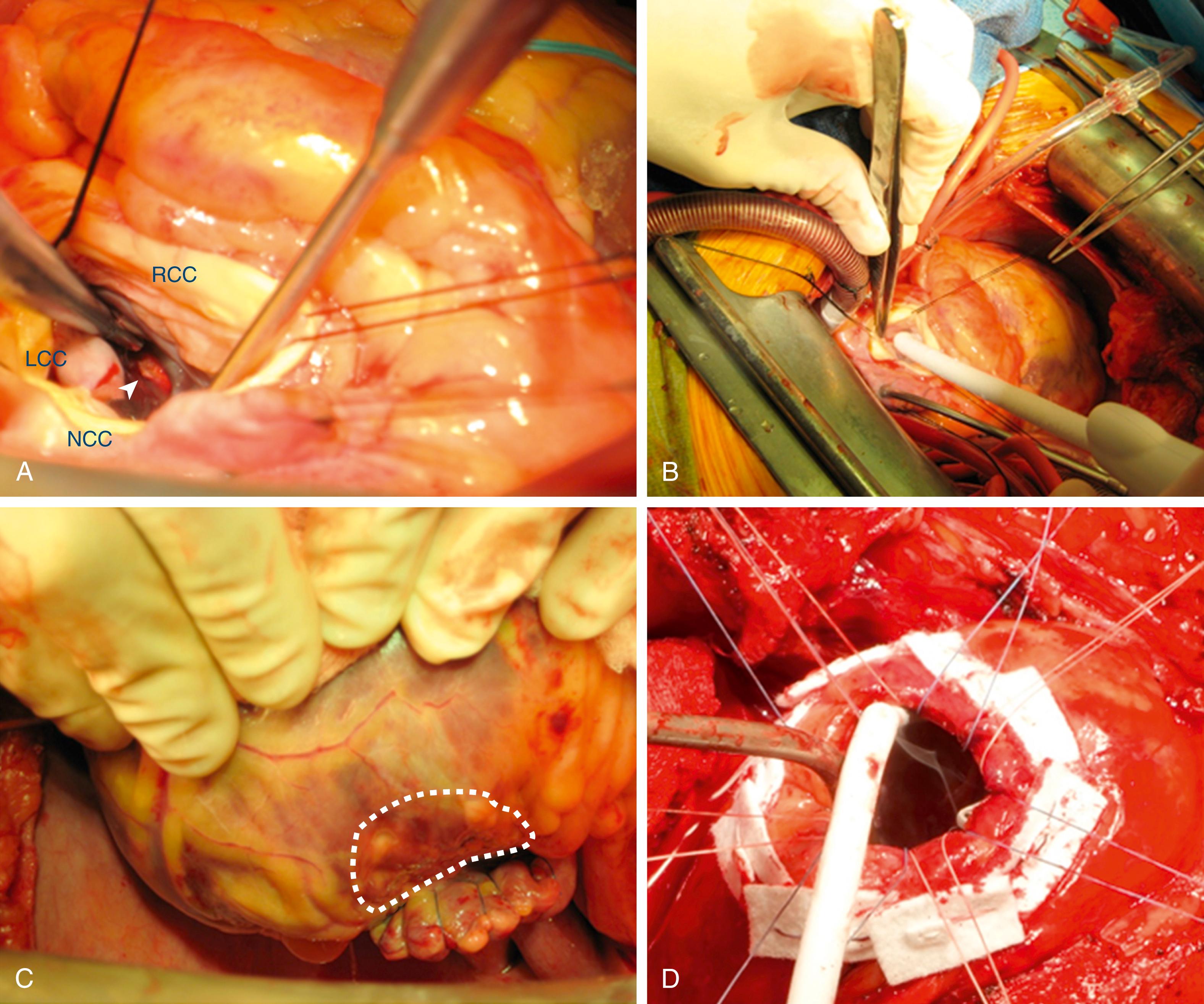
Become a Clinical Tree membership for Full access and enjoy Unlimited articles
If you are a member. Log in here